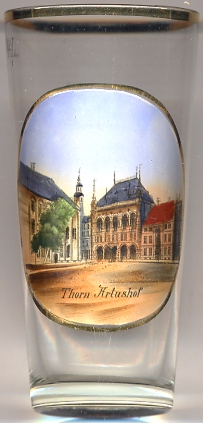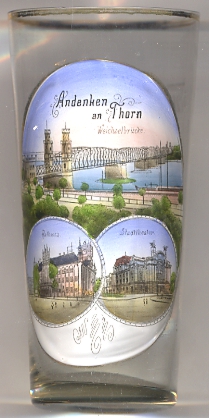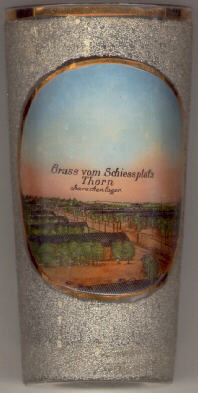

|
| POLSKA | POLAND |
| województwo: Kujawsko-Pomorskie | voivodship: Kuyavia-Pomerania |
| miasto na prawach powiatu: Toruń | city: Toruń |
Toruń (German: Thorn) was founded in 1233 by the Teutonic Order. It soon beacme an important trading place and joined the Hanse Federation of trading towns. The First Peace of Toruń was signed here in 1411 after the Teutonic Order had been defeated in 1410 by the Polish-Lithuanian army of Jagiello I (Prince of Lithuania and since 1385 King of Poland as Wladislaw II). Until the mid-15th century, Toruń belonged to the territory of the Teutonic Order. After the Second Peace of Toruń (1466) the town joined Poland to which it belonged until 1793. After the 3rd Partition of Poland in 1793 Toruń became part of Prussia. During 1807 and 1813 it belonged to the Duchy of Warsaw (personal union with the Kingdom of Saxony) established by Napoleon. After 1813 it belonged to Prussia again (see map), and from 1871 to the newly-founded German Empire. After the Treaty of Versailles after World War I it became part of Poland (see map). Only between 1939 and 1945 it was occupied again by Nazi Germany. Today Toruń is one of the two capitals of the Kujawsko-Pomorskie voivodship: Toruń is the seat of the voivodship assembly, while Bydgoszcz (the former Bromberg) is the seat of the voivode.
Toruń's greatest son is Nikolaus Copernicus (Nikolaus Koppernigk; 1473–1543). He studied at the universities of Kraków, Bologna, Padova and Ferrara. From 1530 on, he was capitular at the cathedral in Frombork (Frauenburg). His astronomical observations convinced him that the sun was the center of the universe. His famous book De Revolutionibus Orbium Coelestium was published in 1543.

The  Artus Court (Dwór Artusa, German: Artushof) [left]
is a landmark of Toruń.
The building dates back to the 14th century, but most parts of the present construction date from the 19th century.
The building was first erected in 1310 and in 1466 was the site of the signing of the Second Peace of Thorn, which concluded the
Thirteen Years' War (1454–1466) between the Prussian Confederation, led by the cities of Danzig (Gdańsk), Elbing (Elbląg),
Kulm (Chełmno) and Thorn, and the Prussian gentry against the rule of the Teutonic Knights in the Monastic State.
The façade of the building was richly decorated in the 17th century. This original building was demolished in 1802 and replaced by a new construction.
This building in turn was demolished and replaced, in 1890, by the Neo-Renaissance construction depicted on glass no. 2755 [left].
Today, the building is used as a culture centre and also is home of the Chamber Orchester of Toruń.
Artus Court (Dwór Artusa, German: Artushof) [left]
is a landmark of Toruń.
The building dates back to the 14th century, but most parts of the present construction date from the 19th century.
The building was first erected in 1310 and in 1466 was the site of the signing of the Second Peace of Thorn, which concluded the
Thirteen Years' War (1454–1466) between the Prussian Confederation, led by the cities of Danzig (Gdańsk), Elbing (Elbląg),
Kulm (Chełmno) and Thorn, and the Prussian gentry against the rule of the Teutonic Knights in the Monastic State.
The façade of the building was richly decorated in the 17th century. This original building was demolished in 1802 and replaced by a new construction.
This building in turn was demolished and replaced, in 1890, by the Neo-Renaissance construction depicted on glass no. 2755 [left].
Today, the building is used as a culture centre and also is home of the Chamber Orchester of Toruń.
[https://de.wikipedia.org/wiki/Artushof_Thorn, http://en.wikipedia.org/wiki/Second_Peace_of_Thorn_(1466)]
Another example of an Artus Court is shown on a glass from Gdańsk.

The  bridge across the river Wisła [left, no. 2961: top picture] was built in 1868–1872. Its 17 spans,
five of which spanned the river, had a total length of 997 metres. The bridge was a combined road and railway bridge. The road traffic was banned when in 1928–1934 a new
road bridge was build. Both bridges were blown up during World War II twice, in 1939 by the retreting Polish army and, after its reconstruction in 1940, in 1945 by the retreating
German forces. The railway bridge was reconstructed in 1948, the road bridge followed in 1950. Since 1999 the railway bridge is named 'Ernest Malinowski Bridge' for a Polish
engineer who built a railroad in the Andes in South America.
bridge across the river Wisła [left, no. 2961: top picture] was built in 1868–1872. Its 17 spans,
five of which spanned the river, had a total length of 997 metres. The bridge was a combined road and railway bridge. The road traffic was banned when in 1928–1934 a new
road bridge was build. Both bridges were blown up during World War II twice, in 1939 by the retreting Polish army and, after its reconstruction in 1940, in 1945 by the retreating
German forces. The railway bridge was reconstructed in 1948, the road bridge followed in 1950. Since 1999 the railway bridge is named 'Ernest Malinowski Bridge' for a Polish
engineer who built a railroad in the Andes in South America.
[http://www.eisenbahnen-der-welt.de/typo/index.php?id=2887, https://de.wikipedia.org/wiki/Toruń, http://www.ostbahn.eu/html/brom_inst_2.html]
The  old town hall [left, no. 2961: bottom left picture] was begun in 1274, extended and rebuilt between
1391 and 1399, extended again at the end of the 16th century and remodeled in Baroque style until the 18th century, is one of the most monumental town halls in Central Europe.
old town hall [left, no. 2961: bottom left picture] was begun in 1274, extended and rebuilt between
1391 and 1399, extended again at the end of the 16th century and remodeled in Baroque style until the 18th century, is one of the most monumental town halls in Central Europe.
[https://en.wikipedia.org/wiki/Toruń, https://de.wikipedia.org/wiki/Toruń]
The  municipal theatre [left, no. 2961: bottom right picture], today named Teatr im. Wilama Horzycy,
was built in 1903–1904 by the architects Ferdinand Fellner and Hermann Helmer from Vienna.
The theatre has 842 seats and originally was intended for German cultural propaganda and therefore only used for performances in German.
Renovated in 1906 it was used since 1918 for Polish theatre performances. Its present name honours the Polish author and theatre director
Wilam Horzyca (1889–1959).
municipal theatre [left, no. 2961: bottom right picture], today named Teatr im. Wilama Horzycy,
was built in 1903–1904 by the architects Ferdinand Fellner and Hermann Helmer from Vienna.
The theatre has 842 seats and originally was intended for German cultural propaganda and therefore only used for performances in German.
Renovated in 1906 it was used since 1918 for Polish theatre performances. Its present name honours the Polish author and theatre director
Wilam Horzyca (1889–1959).
[https://de.wikipedia.org/wiki/Toruń, http://www.andreas-praefcke.de/carthalia/]
For further buildings by Fellner and Helmer depicted on glass of this collection, click here.

The  military training area [left, no. 062] (here labeled in German:
Schießplatz) is located just south of Toruń. The area had been used for military purposes
already since 1605. A permanent military tranng area was cretaged here by the Prussian authorities in 1874. The grounds
were used by the Polish army since 1920. During World War II, the Nazis used the grounds as a POW camp (Stalag 312).
Since 1946 it is used again by the Polish army.
military training area [left, no. 062] (here labeled in German:
Schießplatz) is located just south of Toruń. The area had been used for military purposes
already since 1605. A permanent military tranng area was cretaged here by the Prussian authorities in 1874. The grounds
were used by the Polish army since 1920. During World War II, the Nazis used the grounds as a POW camp (Stalag 312).
Since 1946 it is used again by the Polish army.
Glasses of this collection showing former training areas of the German Empire:
Altengrabow (D),
Arys (Orszysz, PL),
Döberitz (D),
Hagenau (Haguenau, F),
Hammelburg (D),
Hammerstein (Czarne, PL),
Heuberg (Stetten am kalten Markt, D),
Lockstedter Lager (Hohenlockstedt, D),
Münsingen (D),
Munsterlager (Munster, D),
Sennelager (Paderborn, D).
Thorn (Toruń, PL).
Warthelager (Biedrusko, PL).
[https://de.wikipedia.org/wiki/Truppenübungsplätze_(Deutsches_Reich)]
![[scale]](lineal.jpg)